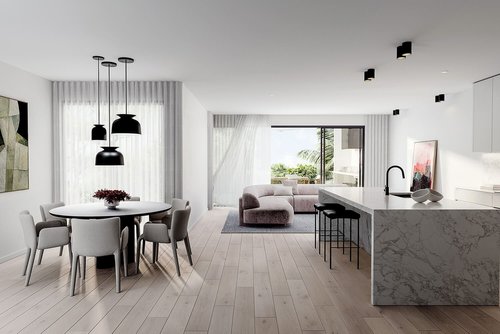Exactly How to Select the Ideal Interior Decoration Aspects for a Natural Living Area
Producing a natural living space needs a critical method to interior style components that reflect both capability and personal design. The journey begins with defining your special visual, complied with by the mindful option of a color scheme that connects the area together.
Specify Your Individual Design

To start the process, consider the components that resonate with you-- these might include specific style movements such as mid-century modern-day, minimalism, or bohemian. Check out various designs with visual ideas, such as magazines, online systems, and showrooms. Create a state of mind board that envelops the shades, structures, and kinds that talk with your aesthetic perceptiveness.
Next, assess your lifestyle and requirements (Interior design Miami). Your personal style needs to not just mirror your tastes but additionally suit your day-to-day tasks and the characteristics of your family. Consider variables like functionality, area use, and maintenance demands
Incorporating individual artefacts or one-of-a-kind items can even more improve your layout story. Inevitably, a well-defined individual style provides a cohesive vision that harmonizes all elements of your space, ensuring it is not just attractive but also a true depiction of who you are.
Choose a Color Combination
A carefully chosen shade palette can significantly raise the psychological and visual impact of any type of indoor room (Luxury Interior designer Miami). The colors you select will certainly not just define the atmosphere but additionally affect the regarded dimension and depth of the rooms. To start, take into consideration the state of mind you wish to grow-- cozy tones like oranges and reds evoke energy and heat, while trendy tones such as blues and environment-friendlies promote harmony and relaxation
Start by selecting a leading shade that reverberates with your personal style. This shade will work as the structure for your combination. Next, select two or 3 complementary shades that harmonize with the dominant shade to produce depth and rate of interest. Using differing tones and colors of these shades can include intricacy without overwhelming the space.
Brilliant, sunlit areas can handle bolder colors, while darker areas may profit from lighter tones to create an illusion of illumination. Guarantee that your selected scheme extends throughout your area, supplying a natural look that connects with each other numerous elements within your home.
Select Complementary Furnishings
Very carefully picking complementary furniture is crucial for enhancing the general visual of your indoor room. The furniture you choose ought to balance with your well established shade scheme, design, and the certain features of the area. Begin by recognizing vital pieces that align with your design vision, such as sofas, chairs, and tables that reflect the desired mood-- be it modern, conventional, or eclectic.
Take into consideration the range and proportion of the furnishings in connection with the space. Oversized items can bewilder smaller sized areas, while fragile furniture may get shed in bigger locations. Objective for a balance where click to read each item adds to the total structure.
Material selection is just as vital; select furniture that not only enhances your color design but also the appearances existing in the room. If you have a sleek, minimalist strategy, opt for furnishings with clean lines and smooth coatings. Conversely, if your design leans in the direction of rustic or bohemian, include recovered timber or upholstered items with rich, inviting textiles.
Incorporate Textures and Patterns
Structures and patterns play a vital function in producing visual dig this passion and depth within your indoor design. By attentively integrating numerous structures and patterns, you can boost the aesthetic allure of your living space, guaranteeing it feels both welcoming and dynamic.
Begin by evaluating the existing components in your space. Take into consideration the structures of your walls, floorings, and furniture.
Patterns can better enhance your design, adding layers and personality. Keep in mind to preserve a cohesive color combination to combine the different patterns.
Integrating appearances and patterns not just enhances aesthetic appeal yet also creates a tactile experience that encourages interaction within the space. By layering these elements thoughtfully, you can achieve a rich and welcoming atmosphere that reflects your personal style while remaining natural.
Add Thoughtful Accessories

Start with a shade scheme that connects your primary layout system. Pick devices such as pillows, flower holders, or artwork that echo these colors to create harmony. Layering appearances is additionally important; for instance, a woven basket or a ceramic sculpture can add deepness and passion to the area.
Furthermore, take into consideration the range and proportion of devices. Oversized pieces can make a vibrant declaration, while smaller sized items can be gathered for a much more intimate feeling. Don't overlook the relevance of individual touches, such as family images or travel keepsakes, which can imbue the space with personality and heat.
Final Thought
In verdict, creating a natural living space calls for a systematic strategy that begins with specifying personal design and establishing a merged shade combination. The option of complementary furnishings, attention to range and percentage, and the consolidation of diverse structures and patterns better improve the room.
Creating a cohesive living room requires a calculated approach to interior style components that reflect both performance and individual style. The trip starts with defining your distinct visual, adhered to by the careful choice of a shade scheme that connects the area with each other.A thoroughly selected shade scheme can substantially boost the psychological and visual impact of any kind of interior area. Using differing tones and tints of these shades can add intricacy without frustrating the space.
In conclusion, producing a cohesive living look at this site room requires a methodical technique that starts with specifying personal style and establishing a combined color palette.